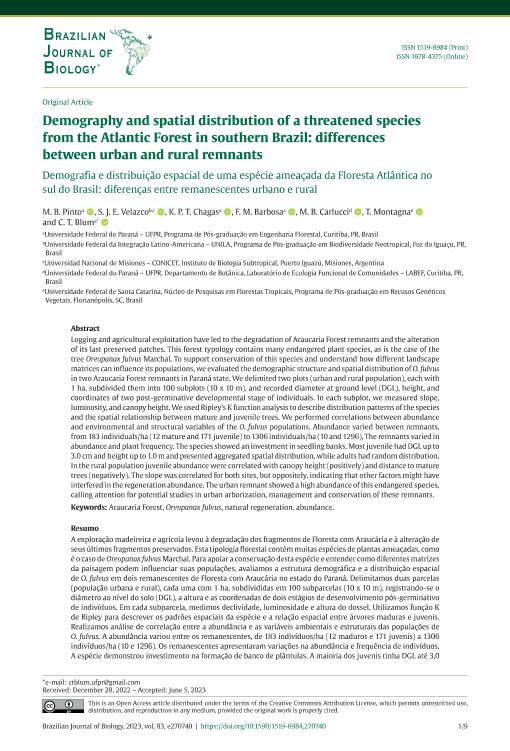Artículo
Logging and agricultural exploitation have led to the degradation of Araucaria Forest remnants and the alteration of its last preserved patches. This forest typology contains many endangered plant species, as is the case of the tree Oreopanax fulvus Marchal. To support conservation of this species and understand how different landscape matrices can influence its populations, we evaluated the demographic structure and spatial distribution of O. fulvus in two Araucaria Forest remnants in Paraná state. We delimited two plots (urban and rural population), each with 1 ha, subdivided them into 100 subplots (10 x 10 m), and recorded diameter at ground level (DGL), height, and coordinates of two post-germinative developmental stage of individuals. In each subplot, we measured slope, luminosity, and canopy height. We used Ripley’s K function analysis to describe distribution patterns of the species and the spatial relationship between mature and juvenile trees. We performed correlations between abundance and environmental and structural variables of the O. fulvus populations. Abundance varied between remnants, from 183 individuals/ha (12 mature and 171 juvenile) to 1306 individuals/ha (10 and 1296). The remnants varied in abundance and plant frequency. The species showed an investment in seedling banks. Most juvenile had DGL up to 3.0 cm and height up to 1.0 m and presented aggregated spatial distribution, while adults had random distribution. In the rural population juvenile abundance were correlated with canopy height (positively) and distance to mature trees (negatively). The slope was correlated for both sites, but oppositely, indicating that other factors might have interfered in the regeneration abundance. The urban remnant showed a high abundance of this endangered species, calling attention for potential studies in urban arborization, management and conservation of these remnants. A exploração madeireira e agrícola levou à degradação dos fragmentos de Floresta com Araucária e à alteração de seus últimos fragmentos preservados. Esta tipologia florestal contém muitas espécies de plantas ameaçadas, como é o caso de Oreopanax fulvus Marchal. Para apoiar a conservação desta espécie e entender como diferentes matrizes da paisagem podem influenciar suas populações, avaliamos a estrutura demográfica e a distribuição espacial de O. fulvus em dois remanescentes de Floresta com Araucária no estado do Paraná. Delimitamos duas parcelas (população urbana e rural), cada uma com 1 ha, subdivididas em 100 subparcelas (10 x 10 m), registrando-se o diâmetro ao nível do solo (DGL), a altura e as coordenadas de dois estágios de desenvolvimento pós-germinativo de indivíduos. Em cada subparcela, medimos declividade, luminosidade e altura do dossel. Utilizamos função K de Ripley para descrever os padrões espaciais da espécie e a relação espacial entre árvores maduras e juvenis. Realizamos análise de correlação entre a abundância e as variáveis ambientais e estruturais das populações de O. fulvus. A abundância variou entre os remanescentes, de 183 indivíduos/ha (12 maduros e 171 juvenis) a 1306 indivíduos/ha (10 e 1296). Os remanescentes apresentaram variações na abundância e frequência de indivíduos. A espécie demonstrou investimento na formação de banco de plântulas. A maioria dos juvenis tinha DGL até 3,0 cm e altura até 1,0 m e apresentaram distribuição espacial agregada, enquanto os adultos tiveram distribuição aleatória. Na população rural a abundância de juvenis foi correlacionada com altura do dossel (positivamente) e com a distância de árvores maduras (negativamente). A declividade foi correlacionada em ambos os locais, mas de forma oposta, indicando que outros fatores podem ter interferido na abundância da regeneração. O remanescente urbano mostrou elevada abundância desta espécie ameaçada, demonstrando um potencial para estudos de arborização urbana, manejo e conservação destes remanescentes.
Demography and spatial distribution of a threatened species from the Atlantic Forest in southern Brazil: differences between urban and rural remnants
Título:
Demografia e distribuição espacial de uma espécie ameaçada da Floresta Atlântica no sul do Brasil: diferenças entre remanescentes urbano e rural
Pinto, M. B.; Velazco, Santiago José Elías ; Chagas, K. P. T.; Barbosa, F. M.; Carlucci, M. B.; Montagna, T.; Blum, C. T.
; Chagas, K. P. T.; Barbosa, F. M.; Carlucci, M. B.; Montagna, T.; Blum, C. T.
 ; Chagas, K. P. T.; Barbosa, F. M.; Carlucci, M. B.; Montagna, T.; Blum, C. T.
; Chagas, K. P. T.; Barbosa, F. M.; Carlucci, M. B.; Montagna, T.; Blum, C. T.
Fecha de publicación:
08/2023
Editorial:
Instituto Internacional de Ecología
Revista:
Brazilian Journal of Biology
ISSN:
1519-6984
e-ISSN:
1678-4375
Idioma:
Inglés
Tipo de recurso:
Artículo publicado
Clasificación temática:
Resumen
Palabras clave:
Araucaria Forest
,
Oreopanax fulvus
,
natural regeneration
,
abundance
Archivos asociados
Licencia
Identificadores
Colecciones
Articulos(IBS)
Articulos de INSTITUTO DE BIOLOGIA SUBTROPICAL
Articulos de INSTITUTO DE BIOLOGIA SUBTROPICAL
Citación
Pinto, M. B.; Velazco, Santiago José Elías; Chagas, K. P. T.; Barbosa, F. M.; Carlucci, M. B.; et al.; Demography and spatial distribution of a threatened species from the Atlantic Forest in southern Brazil: differences between urban and rural remnants; Instituto Internacional de Ecología; Brazilian Journal of Biology; 83; 8-2023; 1-9
Compartir
Altmétricas



